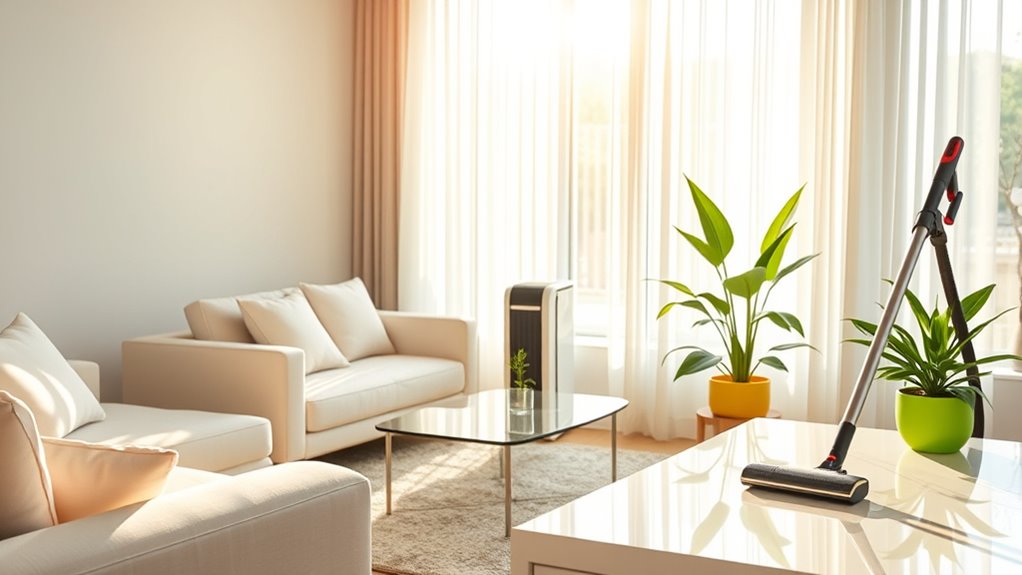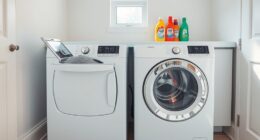To keep your home dust-free and help manage seasonal allergies, start by vacuuming regularly with a Certified Asthma & Allergy Friendly® vacuum. Use damp microfiber cloths for dusting to trap allergens effectively. Wash your bedding weekly in hot water to eliminate dust mites, and keep indoor humidity below 55%. Designate pet-free zones to minimize dander, and invest in air purifiers with HEPA filters. These strategies can make a significant difference, and there’s more you can do to protect your health.
Key Takeaways
- Maintain indoor humidity levels below 55% to control dust mite populations and reduce allergens.
- Regularly wash bedding, pillowcases, and stuffed toys in hot water to eliminate dust mites and germs.
- Use a Certified Asthma & Allergy Friendly® vacuum with HEPA filters to effectively trap dust and allergens during cleaning.
- Dust with damp microfiber cloths to minimize airborne allergens and clean high surfaces first, finishing with floors.
- Create pet-free zones in the home and groom pets regularly to reduce dander and allergens.
Understanding Seasonal Allergies and Dust Allergens
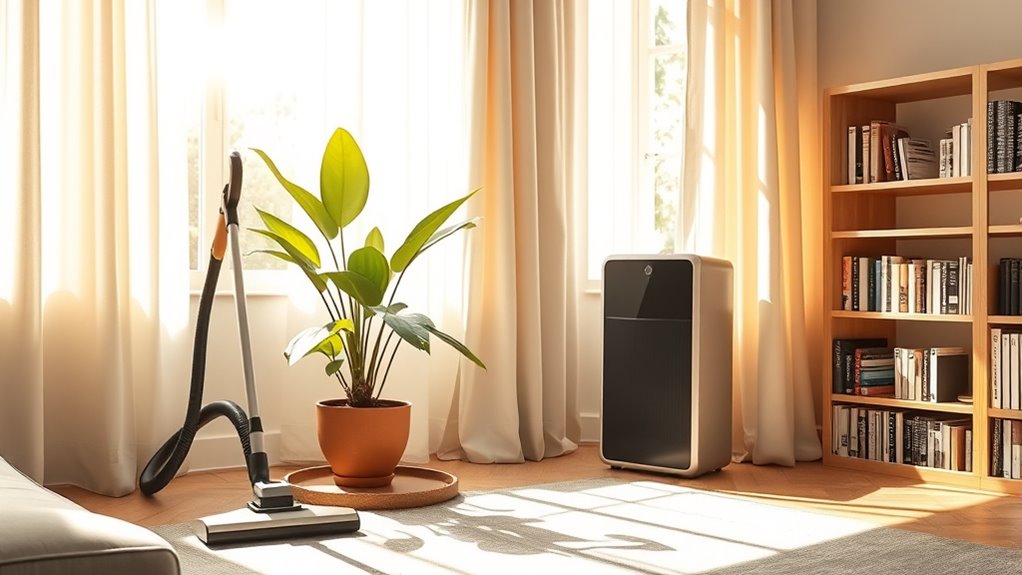
When you understand seasonal allergies and dust allergens, you can take steps to minimize their impact on your life.
Dust mites, thriving in warm, humid environments, are a common indoor allergen found in bedding, upholstery, and carpets. These microscopic creatures can worsen your allergy symptoms, especially when combined with seasonal pollen. Understanding the importance of long-term financial planning can also help you prepare for potential healthcare costs related to allergy treatments. Additionally, staying informed about holistic approaches can offer alternative solutions to managing allergy symptoms. Furthermore, it is essential to recognize that exposure to wood smoke pollutants can exacerbate respiratory issues and allergy symptoms.
To combat this, focus on reducing allergens in your home. Regularly wash sheets in hot water to eliminate dust mites and consider using allergen-proof covers for your bedding.
Additionally, maintaining humidity levels below 55% can greatly control dust mite populations.
Don’t forget that pet dander is also a contributing factor, so make sure you clean your living spaces frequently to keep allergens at bay. Regularly trim cat’s nails to minimize the amount of dander shed in your home.
Effective Cleaning Strategies for a Dust-Free Home
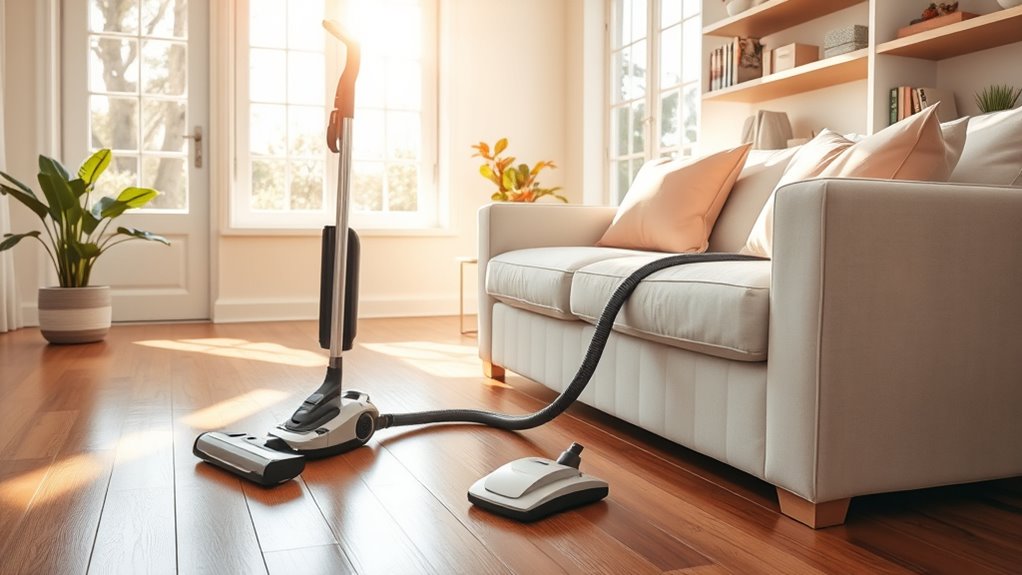
Creating a dust-free home involves implementing effective cleaning strategies that actively reduce allergens. Here are some key practices to follow:
Implementing effective cleaning strategies is essential for creating a dust-free home and reducing allergens.
- Regularly vacuum carpets and upholstery with a Certified Asthma & Allergy Friendly® vacuum cleaner to trap dust mites. Investing in the best HEPA filter vacuums can significantly enhance your cleaning efforts.
- Use damp microfiber cloths for dusting surfaces to minimize airborne allergens. Incorporating essential oils like eucalyptus oil can also help improve air quality while cleaning.
- Wash bedding, pillowcases, and stuffed toys in hot water weekly to eliminate dust mites. This practice is important for reducing bacteria and germs that can exacerbate allergies.
- Stick to a consistent cleaning schedule, dusting high surfaces first and cleaning floors last.
- Maintain good air quality using air purifiers with HEPA filters and replace air filters every 3-6 months. Additionally, ensure proper airflow around the air purifier to enhance performance.
Dust Smart: Best Practices for Reducing Dust Accumulation
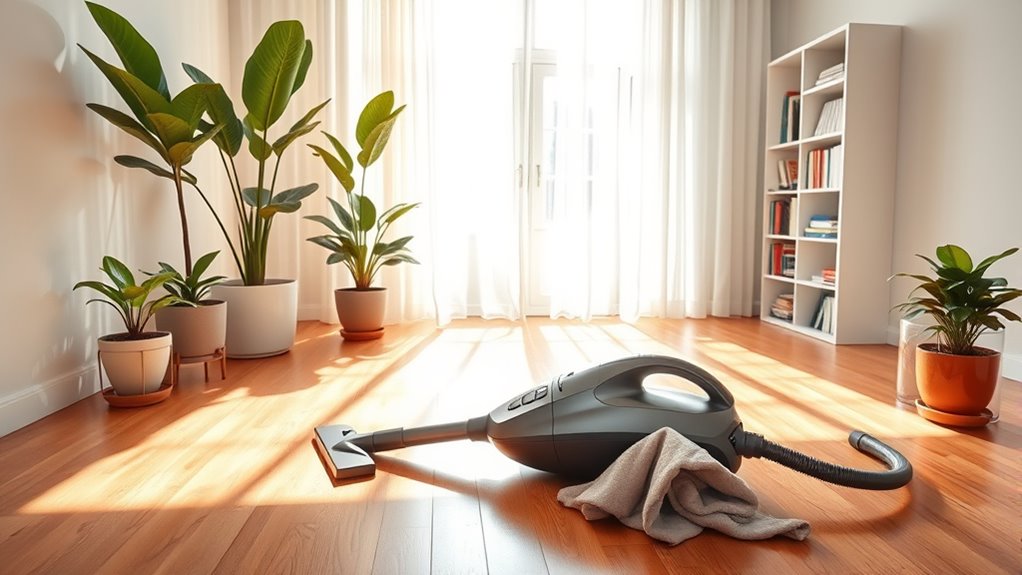
To keep dust at bay, you need to adopt effective dusting techniques and stick to a regular cleaning schedule. Using damp microfiber cloths for dusting traps particles better than dry ones, while cleaning from top to bottom prevents dust from settling back down. Additionally, incorporating regular vacuuming into your routine can significantly improve indoor air quality by removing dust and allergens and fine dust. To maintain your vacuum’s performance, remember to wash filters regularly to ensure optimal airflow. Investing in a best home security system can also help by minimizing outdoor dust infiltration through enhanced sealing and barrier protection. Furthermore, using energy-efficient models for heating or cooling can reduce airborne particles by maintaining consistent indoor temperatures.
Effective Dusting Techniques
Effective dusting techniques can make a significant difference in your home’s cleanliness and air quality.
By following these best practices, you can effectively reduce allergens and dust accumulation:
- Always clean from top to bottom; start with ceiling fans and finish with the floors.
- Use damp microfiber cloths to trap dust particles instead of letting them float around.
- Regularly dust often-overlooked areas like blinds and curtains to minimize mites and other allergens. Incorporating the four-box method can also help you decide what items to keep and what to discard, further reducing clutter. Additionally, maintaining good indoor air quality is crucial for minimizing allergic reactions.
- Incorporate vacuuming into your routine, especially for carpets and upholstery.
- Consider wearing a mask during cleaning to limit inhalation of airborne allergens.
- Additionally, using an air purifier with HEPA filters can help capture and eliminate dust and other pollutants from the air.
Regular Cleaning Schedule
A regular cleaning schedule is a game changer for keeping dust and allergens at bay in your home.
Start by dusting surfaces from top to bottom using damp microfiber cloths; this traps dust particles effectively instead of redistributing them. Clean high surfaces like ceiling fans and blinds first, allowing dust to settle downwards. Regularly using best air purifiers can enhance your home’s air quality by filtering out dust and allergens. Incorporating whole foods into your diet can also boost your immune system, making you less reactive to allergens.
Make sure to vacuum at least once a week with a Certified Asthma & Allergy Friendly® vacuum to greatly reduce dust mites and improve air quality. Regular use of air purifiers can also significantly enhance your home’s overall indoor air quality, helping to reduce allergens and pollutants effectively. Additionally, maintaining proper sprayer cleaning techniques can prevent dust accumulation from leftover paint particles, ensuring a cleaner environment.
Don’t forget to wash your bedding and stuffed toys in hot water (at least 120°F) weekly to manage dust mite allergens.
The Importance of Air Quality in Allergy Management
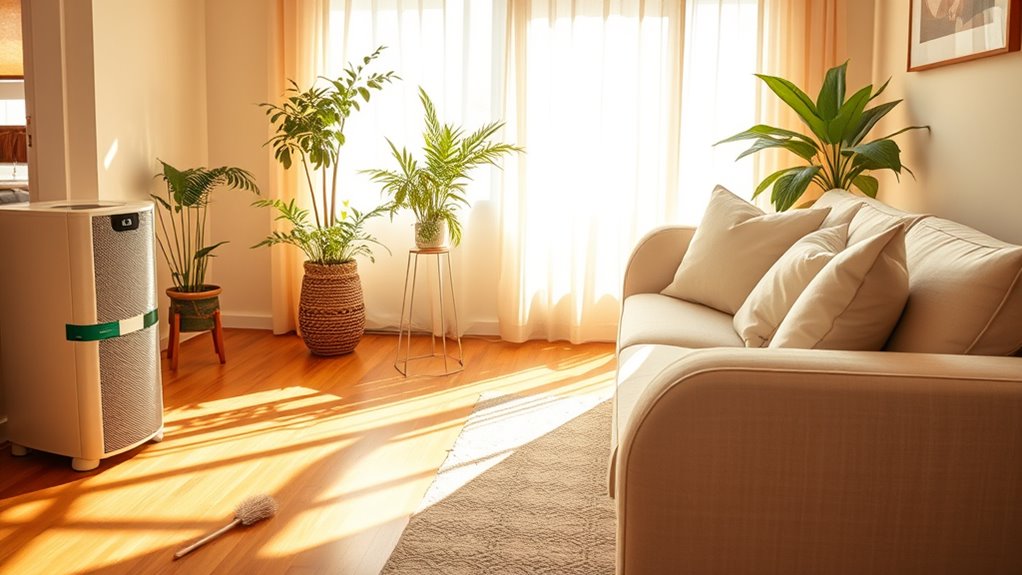
Here are key strategies to enhance your air quality:
- Use air purifiers with HEPA filters to capture allergens. Regular cleaning of air purifiers is essential for optimal performance, and incorporating multi-functionality in your choice of air purifier can provide additional benefits such as odor elimination and enhanced air filtration.
- Maintain humidity levels below 55% to prevent dust mites and mold.
- Regularly replace HVAC filters to keep the air clean.
- Guarantee proper ventilation to disperse accumulated allergens.
- Consider certified asthma and allergy friendly® products for added protection.
Additionally, incorporating models with smart capabilities can enhance your ability to monitor and control air quality effectively. It’s also beneficial to use broad-spectrum sunscreen to protect your skin from UV damage while engaging in outdoor activities.
Managing Pet Allergens and Other Common Triggers

To manage pet allergens effectively, create designated pet-free zones in your home, especially in bedrooms. Regularly grooming your pets can also help reduce dander and loose hair, keeping your living space more comfortable. Additionally, consider implementing home improvement strategies that focus on air purification and minimizing dust accumulation to further enhance your home’s environment for better senior living. Using airless paint sprayers for home improvement projects can also help minimize dust during renovations. Regular veterinary check-ups can also help address any potential common health concerns related to allergies in pets. Furthermore, maintaining clean air quality in your home can significantly reduce allergens, as air purification systems are designed to filter out pet dander and other irritants.
Pet-Free Zones
Creating pet-free zones in your home is crucial for managing allergens and guaranteeing a healthier environment. By designating specific areas, especially bedrooms, you can greatly reduce exposure to animal dander and keep allergens at bay.
Here are some effective strategies:
- Use air purifiers equipped with HEPA filters to trap airborne allergens.
- Regularly vacuum with Certified Asthma & Allergy Friendly® vacuums to maintain low allergen levels.
- Keep windows and doors closed to prevent outdoor allergens from entering.
- Wash and change pet bedding and toys frequently to minimize dander accumulation.
- Establish a routine cleaning schedule to guarantee consistent air quality.
Regular Grooming Routine
Regular grooming is essential not only for your pet’s health but also for reducing allergens in your home. By brushing your pet outdoors at least once a week, you can considerably lower dander and loose hair—common triggers of allergies.
Bathing your pet every 1-2 weeks also helps minimize dander, enhancing your quality of life if you’re sensitive to pet allergens.
Designate pet-free zones, especially in bedrooms, to further limit exposure to pet dander.
Don’t forget to utilize air purifiers with HEPA filters in areas where pets are allowed; they effectively trap allergens like dust mites.
Finally, maintain a cleaning schedule and vacuum with a HEPA vacuum to keep your home dust-free and allergen-free.
Choosing the Right Cleaning Tools and Products
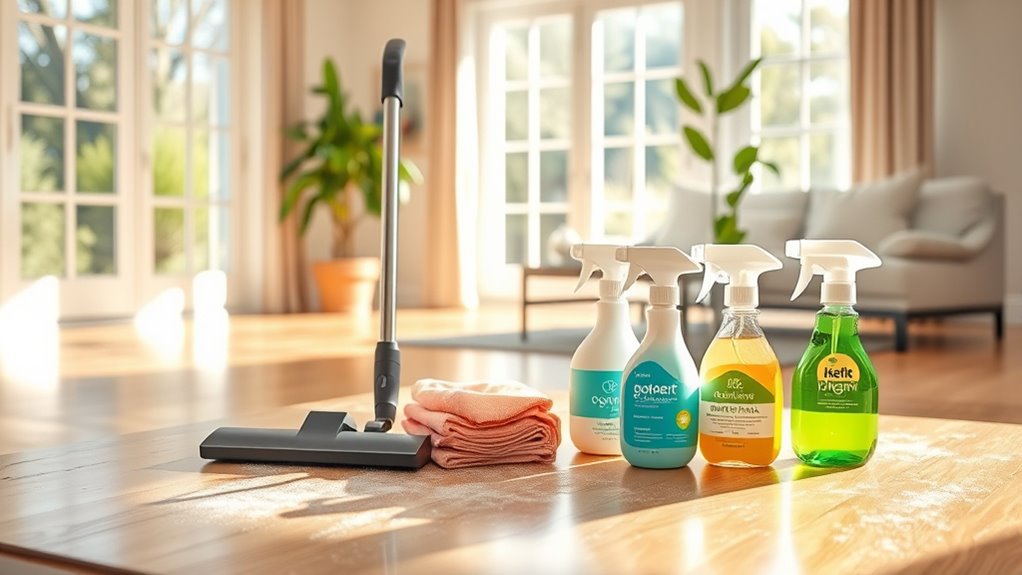
When it comes to maintaining a dust-free home, selecting the right cleaning tools and products is essential for effectively managing allergens. Here are some tips to help you choose wisely:
- Opt for vacuums with HEPA filters that trap dust mites and prevent allergens from re-entering the air.
- Use damp microfiber cloths instead of dry ones to trap dust and reduce airborne particles.
- Choose fragrance-free cleaning products to minimize irritation and allergy symptoms.
- Regularly replace air filters in your HVAC system with allergy-friendly options every 3-6 months.
- Select cleaning agents designed to combat mold particles and allergens for a more effective cleaning process.
With these tools, you can considerably reduce allergens and create a healthier indoor environment.
Maintaining a Healthy Indoor Environment Year-Round
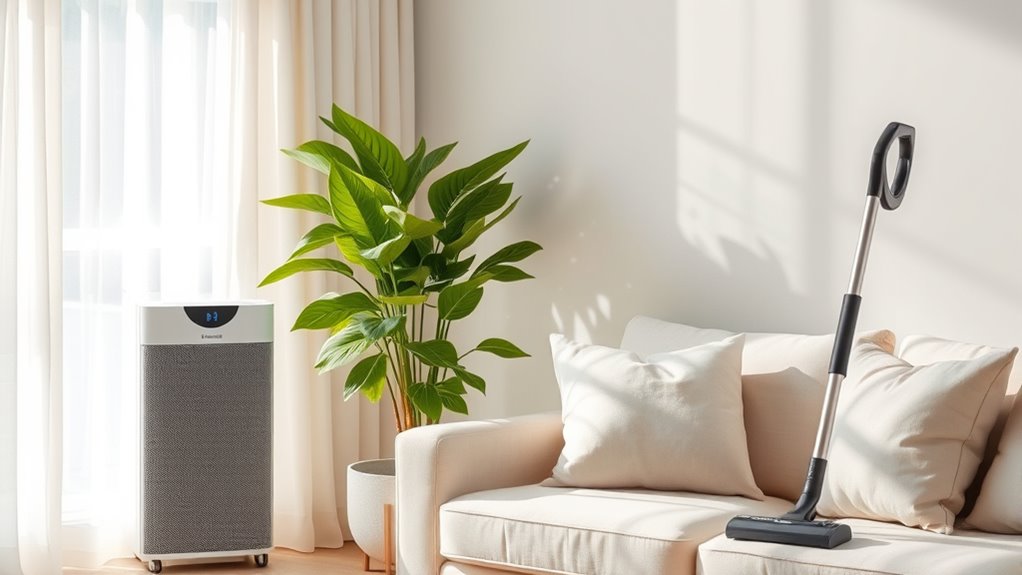
Keeping your home free of dust and allergens is just the beginning of maintaining a healthy indoor environment year-round.
Regular vacuuming with a HEPA-filter vacuum at least once a week is essential for capturing dust mites and other allergens. Control your indoor humidity below 55% to deter dust mite and mold growth, creating a more comfortable space for allergy sufferers.
Don’t forget to use zippered allergen-resistant covers on your mattresses and pillows to further minimize exposure. Implement proper ventilation and invest in air purifiers with HEPA filters to enhance your air quality, reducing airborne allergens like pet dander and pollen.
Finally, wash your bedding and stuffed toys in hot water weekly to kill dust mites and lower allergens effectively.
Frequently Asked Questions
How Do I Stop Dust Allergies in My House?
To stop dust allergies in your house, keep humidity below 55% to prevent dust mites.
Wash your bedding and soft toys weekly in hot water to eliminate allergens.
Use allergen-resistant covers on pillows and mattresses to reduce exposure.
Vacuum at least once a week with a HEPA-filter vacuum to trap dust particles.
Finally, maintain a clean, uncluttered space and dust surfaces using damp microfiber cloths to avoid spreading allergens.
How Do You Clean Your House if You Have Allergies?
Did you know that a typical home can harbor over 40 pounds of dust annually?
To clean your house effectively if you have allergies, start by using a vacuum with a HEPA filter weekly.
Dust surfaces with damp microfiber cloths to trap allergens.
Wash bedding and stuffed toys in hot water weekly, and keep windows closed during high pollen seasons.
Don’t forget to wear a mask while cleaning to protect your respiratory health!
How Do You Remove Dust and Allergens From the Air?
To remove dust and allergens from the air, start by using air purifiers equipped with HEPA filters. These effectively capture airborne particles.
You should also replace your HVAC filters every 3-6 months with allergy-friendly options. Maintain indoor humidity below 55% to deter dust mites and mold.
Regularly vacuum with a HEPA filter vacuum and dust surfaces with damp microfiber cloths to minimize allergens.
Finally, ventilate your home by opening windows when outdoor conditions permit.
How Do You Treat Dust Allergy in the House?
Did you know that about 20 million Americans suffer from dust allergies?
To treat dust allergies in your home, start by washing bedding and stuffed toys weekly in hot water to eliminate dust mites.
Use allergen-resistant covers on pillows and mattresses, and vacuum regularly with a HEPA-filter vacuum.
Keep humidity below 55% to discourage mold and dust mites, and dust surfaces with damp cloths to prevent allergens from becoming airborne.
Conclusion
In your quest for a dust-free haven, think of your home as a sanctuary, where every breath feels like a revitalizing breeze. By implementing these strategies, you’re not just battling seasonal allergies; you’re crafting a vibrant, healthy environment. With a little effort and the right tools, you can keep allergens at bay, transforming your space into a refuge of comfort. So roll up those sleeves, and let your home shine like a beacon of wellness!

